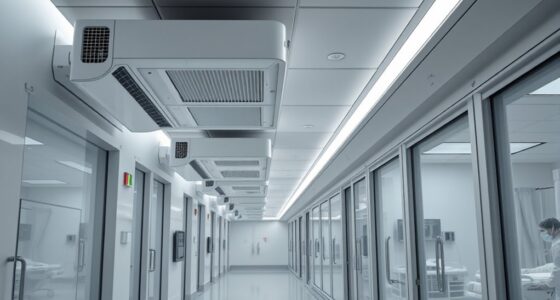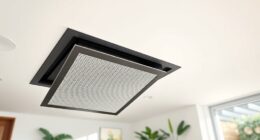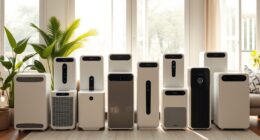To improve air quality in low-income housing affordably, consider natural ventilation like opening windows and creating cross-ventilation, especially when outdoor conditions allow. Regular cleaning and maintaining existing ventilation systems also help reduce indoor pollutants. Using low-cost HEPA air purifiers is another effective option. Community programs might offer free or subsidized devices and maintenance services. Continue exploring practical strategies to breathe easier and create healthier indoor environments for you and your family.
Key Takeaways
- Portable HEPA air purifiers are affordable and effective for removing indoor pollutants in low-income housing.
- Natural ventilation strategies like opening windows and cross-ventilation improve air quality cost-effectively.
- Regular cleaning and maintenance of existing ventilation systems enhance indoor air conditions.
- Community programs can provide subsidized or free air purifiers and maintenance services.
- Upgrading or installing basic exhaust fans reduces humidity and airborne toxins at low cost.

Have you ever wondered how clean the air is inside low-income housing? It’s a question many people overlook, but it’s essential for your health and well-being. The quality of indoor air can considerably affect your comfort, especially if you or your family members have allergies, asthma, or other respiratory issues. One of the key factors in maintaining good air quality is proper ventilation. Unfortunately, in many low-income housing units, ventilation systems are either outdated or poorly maintained, leading to stale, polluted air that can contain dust, mold spores, pet dander, and even airborne toxins. These issues aren’t just uncomfortable; they can be dangerous over time, increasing health risks for residents.
Indoor air quality in low-income housing often suffers from poor ventilation, risking health from dust, mold, pet dander, and toxins.
The good news is that improving air quality doesn’t have to be expensive. Simple, affordable solutions can make a big difference. For example, upgrading or installing basic ventilation systems can help circulate fresh air and remove indoor pollutants. Exhaust fans in kitchens and bathrooms are often neglected but play an essential role in reducing humidity and removing airborne contaminants generated during cooking or bathing. These fans help prevent mold growth and reduce odors, directly improving the indoor environment. If your unit lacks these features, requesting maintenance or exploring low-cost alternatives, like portable air purifiers with HEPA filters, can considerably enhance the air you breathe.
Another affordable approach involves using natural ventilation strategies. When weather permits, opening windows and vents can allow fresh air to enter and stale air to exit, diluting indoor pollutants. Cross-ventilation—opening windows on opposite sides of your home—can maximize airflow without extra costs. Additionally, keeping interior doors open can facilitate better circulation, ensuring that air doesn’t stagnate in one area. While these methods depend on external conditions, they’re simple and effective ways to boost indoor air quality without spending money.
Furthermore, maintaining cleanliness plays a crucial role. Regular dusting, vacuuming with HEPA filters, and controlling sources of indoor pollution—like smoking indoors or storing chemicals properly—are cost-effective strategies for cleaner air. Some residents also explore community programs that provide free or subsidized air purifiers or maintenance services for ventilation systems, especially in low-income areas where residents might not have the resources to upgrade their units. Incorporating subvended maintenance services can significantly improve long-term indoor air quality and health outcomes.
Frequently Asked Questions
How Do Air Purifiers Impact Energy Bills in Low-Income Housing?
Air purifiers can increase your energy bills because they require energy for operation, impacting energy consumption. However, choosing models with high cost efficiency helps keep costs manageable. To minimize this impact, opt for energy-efficient air purifiers and use them only when necessary, such as during high pollution days. Proper maintenance also ensures they run efficiently, helping you balance better air quality with affordable energy use.
Are DIY Air Purification Solutions Effective and Safe?
DIY air purifiers are like a double-edged sword; while they can be cost-effective, their effectiveness and safety concerns can cut deep. You might find some success with simple solutions like activated charcoal or HEPA filters, but they often lack rigorous testing and certification. This means DIY effectiveness isn’t guaranteed, and safety concerns—like fire hazards or poorly filtered air—could put your health at risk. Proceed cautiously and consider professional-grade options when possible.
What Maintenance Is Required for Affordable Air Purification Devices?
You need to regularly replace filters and clean your device to keep it working effectively. Check the manufacturer’s instructions for filter replacement intervals, usually every 3 to 6 months. Clean the exterior and any accessible parts with a damp cloth weekly to prevent dust buildup. Proper maintenance guarantees your air purifier functions efficiently, improves air quality, and prolongs its lifespan without adding extra costs.
Can Air Purifiers Eliminate All Indoor Pollutants?
Did you know that air purifiers can remove over 90% of common indoor pollutants? However, they can’t eliminate all indoor pollutants due to air purifier limitations, like size or filter type. While they improve air quality markedly, pollutant removal effectiveness varies. You should understand that some pollutants, such as gases or viruses, may require specialized filters or additional measures for complete removal.
How Do Climate and Weather Affect Air Purifier Performance?
Climate and weather considerably impact your air purifier’s performance. High humidity levels can cause mold growth and reduce filter efficiency, while low humidity may dry out your air and make purification less effective. Seasonal variations also play a role; for example, pollen in spring or dust in winter can increase indoor pollutants. To maintain peak performance, adjust your purifier settings and replace filters more frequently during extreme weather conditions.
Conclusion
Imagine stepping into a home where the air feels fresh and clean, wrapping you in a breath of hope. Affordable air purification transforms your space into a sanctuary, shielding you from unseen dangers and brighter days ahead. Every breath becomes a small act of resilience, reminding you that clean air isn’t a luxury but a right. Together, we can create healthier environments where every inhale sparks new beginnings and lasting change.









